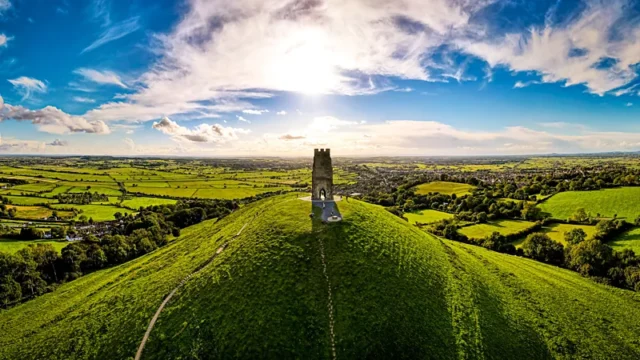Reviving Britain’s Sacred Wetlands: The Avalon Marshes
Introduction
Glastonbury, a town rich in myth and history, is also the focal point of a remarkable environmental initiative—the Avalon Marshes project. This effort aims to transcend the mythical allure of the region and deliver tangible ecological benefits.
Somerset: England’s Historical Heartland
Somerset is a county steeped in history. It was from the fortress of Athelney in the 9th Century that Alfred the Great launched military campaigns pivotal to the birth of the English nation. Nearby, the ruins of Glastonbury Abbey are said to be the resting place of the legendary King Arthur. Sites like Glastonbury Tor still attract those who believe in their spiritual power.
Glastonbury’s Folklore and Modern Identity
Today, Glastonbury is a small town filled with bohemian shops that capitalize on its rich folklore. One such shop, The Hollow Hills Bookshop, offers works by British occultist Dion Fortune, including her 1934 book “Avalon of the Heart,” which links Glastonbury to the Isle of Avalon from Arthurian legend.
The Somerset Levels: From Inland Sea to Farmland
Glastonbury is situated in the Somerset Levels, a flat plain of green fields between the Mendip and Blackdown Hills. This area was once a vast inland sea, with higher points like Athelney and Glastonbury Tor standing as swamp-surrounded islands. The Romans began draining the Levels to reclaim land for agriculture, a practice that has continued ever since despite the land’s low productivity.
Environmental Impact of Draining the Levels
The draining of the Somerset Levels has had devastating effects on biodiversity. Historically, the area was teeming with wildlife, including beavers, salmon, lynx, and wild horses. Environmentalist Ben Goldsmith notes that the drive to use every inch of land for food production has led to significant wildlife population declines since World War I.

The Avalon Marshes Project: Restoring Biodiversity
The Avalon Marshes project, located just west of Glastonbury, aims to reverse some of this damage. By protecting areas from agricultural and industrial use and reintroducing water to the landscape, the project is restoring the original wetland habitat.
Shapwick Heath: A Conservation Success Story
At Shapwick Heath, a major conservation area within the Avalon Marshes, senior reserve manager Louise Treneman explains the importance of wet woodland habitats and peat restoration. Peat, a carbon-rich soil, has been harvested since Roman times. Degraded peat releases significant amounts of carbon dioxide, but restoring it can sequester carbon long-term.

Visiting the Avalon Marshes
The Avalon Marshes are open year-round, with amenities including parking, toilets, an information center, and a café. Visitors can explore self-guided walking and cycling trails, bird hides, and information boards. The Avalon Archaeology Center offers guided tours showcasing the area’s human history through recreated longhouses, Viking boats, and Roman villas.
Biodiversity Gains from Peat Restoration
Restoring peat and wetlands has brought back several species that were once locally extinct. Bitterns, a type of long-beaked bird, have made a significant comeback. Their distinctive “boom” call, reminiscent of someone blowing across a large bottle, can now be heard across the Levels.
Archaeological Significance of the Wetlands
The wetlands’ preservation is also crucial for archaeology. The Sweet Track, built in 3806 BCE, is the UK’s earliest built human trackway and one of Europe’s oldest. It was discovered in the 1970s perfectly preserved in the acidic, oxygen-poor peat. Artifacts like jadeite axes from the Italian Alps and a wooden replica axe believed to be the UK’s oldest toy have been found here.
Staying Near the Avalon Marshes
Visitors can stay in rural bed and breakfasts or campsites nearby, such as Garslade Farm. The towns of Glastonbury and Street offer a variety of accommodations, from B&Bs to luxury hotels, along with diverse dining options.
Westhay Moor: A Mosaic of Landscapes
Mark Blake, a senior reserve manager, leads tours through Westhay Moor, showcasing reed beds, open water, fen, and mire landscapes. Species like the great egret and the large marsh grasshopper, which had been extinct in the area, have returned thanks to conservation efforts.

The Future of the Avalon Marshes
The restoration of the Avalon Marshes is poised to create a landscape rich in both history and wildlife. Ben Goldsmith envisions a future where the area could rival France’s Camargue region or the Danube Delta, with reintroduced species like beavers and Dalmatian pelicans.
Conclusion
The Avalon Marshes project is a beacon of hope for environmental conservation in Britain. By reviving the Somerset Levels, this initiative is creating a sustainable future that honors the region’s historical and mythical legacy while fostering biodiversity and ecological resilience. Visitors to the area can witness firsthand the transformative power of nature conservation in one of England’s most storied landscapes.











